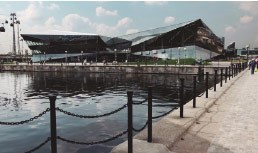The Crystal, the global center for sustainable urban development built and managed by Siemens, is setting new standards in environmentally friendly and sustainable buildings. This achievement is reinforced by another recognition that the Crystal has recently obtained: LEED (Leadership in Energy and Environmental Design) Platinum. In July 2013, the building was awarded the BREEAM (Building Research Establishment Environmental Assessment) “Outstanding” certification, followed by LEED Platinum in September. This makes the Crystal the only building in the world with the highest category in both certification systems.
“We have put a lot of effort into making Crystal one of the most sustainable and energy-efficient buildings in the world, setting the highest standards in design, construction, technology and operation from the outset,” says Pedro Miranda, manager of the Siemens Global Competence Center. Cities. “We are pleased that our solutions in technology and innovation in energy efficiency and sustainability have materialized in the Crystal, by reaching the highest levels of LEED Platinum and BREEAM Outstanding certification, and by setting a new benchmark for the sector. ”.
The Crystal, whose shape and structure mimics that of a rock crystal, is a unique building. Spanning over 6300 square meters in the historic Royal Victoria Dock area of East London, the building runs entirely on electricity and does not consume any fossil-based resources such as gas or oil. Instead, it uses renewable energy sources, including power from the London Array offshore wind farm. Located in the ground below the Crystal are two conduction systems that are more than 17 kilometers long and reach depths of up to 150 meters. Equipped with heat pumps, they satisfy all the heating and cooling needs of the building.
In addition, a rooftop photovoltaic system also generates electricity for the Crystal. With an area of 1580 square meters, this system generates approximately 20% of the total demand for electricity, which is roughly equivalent to the demand of geothermal heat pumps for the generation of cold and heat.
Another 19 square meters of solar thermal panels help produce hot water. In total, the Crystal consumes 46% less energy and emits 65% less carbon dioxide than comparable office buildings.
The passive design that gives the building its extraordinary angular and cutting forms guarantees adequate natural lighting of the interior. The natural ventilation system, with 150 controllable openings in the façade, reduces the cost of mechanical ventilation. Triple-glazed windows, with a g-value of 0,3, maximize the building's insulation efficiency. Rainwater, as well as gray water and black water (both wastewater, but with different levels of contamination) are collected and treated in Crystal itself, so that the building can use every last drop of water.
Siemens' advanced Desigo building automation system controls and monitors all the building's operating parameters, while remote maintenance is handled by the Advanced Operations Center (AOC) in Frankfurt, Germany. Anyone in the Crystal, internal or visitor, can see the updated water and energy consumption data on the “Green Building” screens, thus motivating them to adopt sustainable and environmentally friendly practices in their private life. All these innovative, active and passive operating, construction and design parameters contributed to obtaining the LEED Platinum certification in the LEED For New Construction and Major Renovations category (v. 2009). The Crystal scored top marks in the Water Efficiency (10/10), Innovative Design (6/6) and Regional Priorities (4/4) categories and close to the top in the Sustainable Locations (24/26), Quality of indoor environment (10/15) and energy and atmosphere (28/35). In addition, the building achieved 4 points out of 14 in the Materials and Resources category thanks to its systematic waste management. This category mainly evaluates the reduction of waste through the reuse of pre-existing structures, an element not applicable to Crystal, since it is a newly built building. In total, the Crystal scored 86 out of a possible 110 points.



